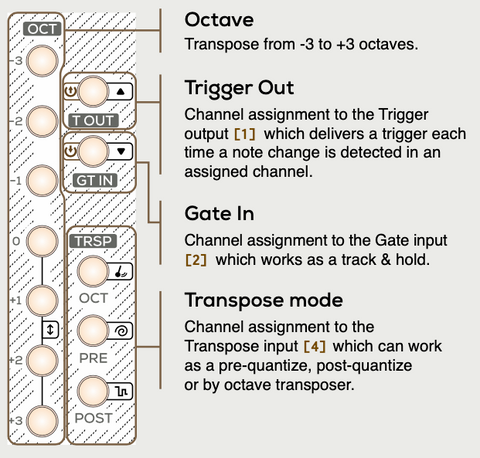
Shakmat Modular Bard Quartet
Format: Eurorack
Width: 10HP
Depth: 29mm
Current: 60mA @ + 12V, 10mA @ -12V
Manual PDF (English)

Format: Eurorack
Width: 10HP
Depth: 29mm
Current: 60mA @ + 12V, 10mA @ -12V
Manual PDF (English)
The Shakmat Modular Bard Quartet is a programmable 4-channel quartet. With a keyboard integrated with four channels, you can control up to four different instruments, and Bard Quartet creates a pleasing quartet from musical ideas.You can also freely navigate the eight customizable harmonic progressions with the knobs to create the entire song.
The Bard Quartet can store 320 scales (4 channels, 8 harmonies, 10 memory slots).In addition, it has flexible micro-tuning and arpeggiator capabilities, as well as three assignable inputs and outputs.
Use the 12 buttons arranged on the keyboard to set the scale for each channel.The active scale button lights up brighter than the other selected scales, so you can see the scale in real time.The channel you want to edit can be selected with the four Channel buttons below the Harmony knob.
Once you've set the scale for each channel you want to use, you can operate the Harmony knob to repeat this process at eight different harmony positions.This creates the chord progression that forms the basis of the song structure, and you can quickly access different harmonies by turning the knob.
Bard Quartet allows you to group up to 4 channels. By holding down the Channel button and pressing the other Channel buttons, the scale of the first channel is copied to the second channel and you can edit the common scale applied to both channels.You can create any combination of groups, and the Channel LEDs for the grouped channels will all light up at the same time.
Press and hold the Edit button to access the edit menu of the octave switch, trigger output, gate input, and transpose input functions for each channel and harmony.The Edit button lights up while the menu is active, and you can exit the menu by pressing the button again.
Each channel can also be used as an arpeggiator.The channel set on the arpeggiator will now respond to the trigger signal rather than a voltage change to the CV input. When you press the ARPG button, the button lights up, indicating that you are accessing the arpeggiator menu.Press the button again to exit the menu.To set any channel as an arpeggiator, hold down the ARPG button and press the desired Channel button.The button for the set channel will change to blinking to indicate that you are in arpeggiator mode.Changing the channel to arpeggiator will apply to all harmony locations.The Arpeggiator menu also allows you to set octave spreads for each arpeggiator mode, channel, and harmony.
Bard Quartet's micro-tuning feature allows each note in 12 equal temperament to be detuned 50 cents above and below a semitone. When you press the μTune button, the button lights up, indicating that you are accessing the Microtunig menu.You can exit the menu by pressing the button again.
The notes to be detuned for each channel and harmony can be individually selected with the Keyboard button, and detuning is done with the Harmony knob.As you can see in the image above, when the knob is in the center position, it is in harmony, and turning the knob to the right can detune the note up to +50 cents, and turning it to the left can detune it up to -50 cents. The Keyboard button for the note will change to blinking.To clear the micro-tuning of all notes for a particular channel and harmony, press and hold the μTune button for 4 seconds and make sure the button flashes. When exiting the Microtuning menu, the Harmony knob position may not match the playing harmony, but passing through the current harmony value will resynchronize the knob position.
Current settings, including progress to 8 harmonies, can be stored in 10 slots of non-volatile memory. To access the Memory menu, press the Edit and ARPG buttons at the same time.This will cause the Edit button to light up and the ARPG button to blink, indicating that you are accessing the Memory menu.This menu includes reading and writing memory slots, as well as operations within the slots. To exit the Memory menu, press the ARPG and Edit buttons.
Access the Options menu by pressing the Edit and μTune buttons at the same time. The Edit button lights up and the μTune button flashes to indicate that you are accessing the Options menu.This menu isIt has different options for grouping channels and interacting between channels, and these settings apply to the entire current slot. To exit the Options menu, press the Edit and μTune buttons.
If you select a setting in the Edit menu or the Arpeggiator menu, these apply to the independent harmonies of a particular channel, but you can set the setting by holding down the Channel button before selecting the setting with the Keyboard button. It can be generalized to all harmonies of a particular channel.
You can edit the scale, edit, and arpeggiator settings for a particular harmony while playing another harmony. When the μTune button is held down, the module separates the Harmony knob from the playing harmony.This gives the Harmony knob the freedom to navigate the harmony you want to edit. When the μTune button is released, the Harmony knob will follow the playing harmony again.You can also use this feature to easily navigate non-adjacent harmonies.
The Bard Quartet can control not only V / Oct standard Eurorack equipment, but also Hz / V and 1.2V / Oct standard instruments.To change the output criteria for a particular channel, enter the Microtuning menu, then hold down the μTune button and press the Channel button.The output standard is indicated by the blinking pattern of the Channel button as shown below.
To restore factory memory, press and hold the ARPG button at power up and press the μTune button to apply.All buttons will flash until the factory memory is restored.